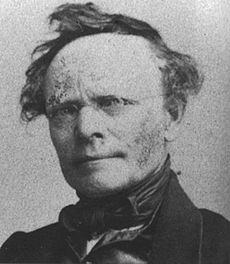
Johann Jakob Kaup
Encyclopedia

Germany
Germany , officially the Federal Republic of Germany , is a federal parliamentary republic in Europe. The country consists of 16 states while the capital and largest city is Berlin. Germany covers an area of 357,021 km2 and has a largely temperate seasonal climate...
naturalist.
Biography
He was born at DarmstadtDarmstadt
Darmstadt is a city in the Bundesland of Hesse in Germany, located in the southern part of the Rhine Main Area.The sandy soils in the Darmstadt area, ill-suited for agriculture in times before industrial fertilisation, prevented any larger settlement from developing, until the city became the seat...
. After studying at Göttingen
Göttingen
Göttingen is a university town in Lower Saxony, Germany. It is the capital of the district of Göttingen. The Leine river runs through the town. In 2006 the population was 129,686.-General information:...
and Heidelberg
Heidelberg
-Early history:Between 600,000 and 200,000 years ago, "Heidelberg Man" died at nearby Mauer. His jaw bone was discovered in 1907; with scientific dating, his remains were determined to be the earliest evidence of human life in Europe. In the 5th century BC, a Celtic fortress of refuge and place of...
he spent two years at Leiden, where his attention was specially devoted to the amphibians and fish
Fish
Fish are a paraphyletic group of organisms that consist of all gill-bearing aquatic vertebrate animals that lack limbs with digits. Included in this definition are the living hagfish, lampreys, and cartilaginous and bony fish, as well as various extinct related groups...
es. He then returned to Darmstadt as an assistant in the grand ducal museum, of which in 1840 he became inspector. In 1829 he published Skizze zur Entwickelungsgeschichte der europäischen Thierwelt, in which he regarded the animal world as developed from lower to higher forms, from the amphibians through the birds to the beasts of prey; but subsequently he repudiated this work as a youthful indiscretion, and on the publication of Darwin
Charles Darwin
Charles Robert Darwin FRS was an English naturalist. He established that all species of life have descended over time from common ancestry, and proposed the scientific theory that this branching pattern of evolution resulted from a process that he called natural selection.He published his theory...
's Origin of Species he declared himself against its doctrines. The extensive fossil
Fossil
Fossils are the preserved remains or traces of animals , plants, and other organisms from the remote past...
deposits in the neighbourhood of Darmstadt gave him ample opportunities for palaeontological
Paleontology
Paleontology "old, ancient", ὄν, ὀντ- "being, creature", and λόγος "speech, thought") is the study of prehistoric life. It includes the study of fossils to determine organisms' evolution and interactions with each other and their environments...
inquiries, and he gained considerable reputation by his Beiträge zur näheren Kenntniss der urweltlichen Säugethiere (1855–1862). He also wrote Classification der Säugethiere und Vögel (1844), and, with Heinrich Georg Bronn
Heinrich Georg Bronn
Heinrich Georg Bronn was a German geologist and paleontologist.Bronn was born at Ziegelhausen near Heidelberg. Studying at the university of Heidelberg he took his doctor's degree in the faculty of medicine in 1821, and in the following year was appointed professor of natural history...
, Die Gavial-artigen Reste aus dem Lias (1842–1844).
He died at Darmstadt.
Mastodon fossil
A particularly important incident in the history of paleontology involves Kaup. In 1854 he bought the American mastodon found in 1799 in Orange County, New YorkOrange County, New York
Orange County is a county located in the U.S. state of New York. It is part of the Poughkeepsie–Newburgh–Middletown, NY Metropolitan Statistical Area and is located at the northern reaches of the New York metropolitan area. The county sits in the state's scenic Mid-Hudson Region of the Hudson Valley...
. This is the mastodon immortalized in Charles Willson Peale
Charles Willson Peale
Charles Willson Peale was an American painter, soldier and naturalist. He is best remembered for his portrait paintings of leading figures of the American Revolution, as well as establishing one of the first museums....
's painting of the 1801 excavation (painting executed between 1806 and 1808). This mastodon was on display for many years in Peale's Museum and is currently on display in Hessisches Landesmuseum Darmstadt
Hessisches Landesmuseum Darmstadt
Hessisches Landesmuseum Darmstadt is a multidisciplinary museum in Darmstadt, Germany.The museum is especially noted for its natural history collections, for instance fossils from the nearby Messel pit and an historic American mastodon purchased by the Darmstadt naturalist Johann Jakob KaupIt also...
, Germany This mastodon is the first complete example found in the United States, and may be only the second fossil animal ever mounted for display.

